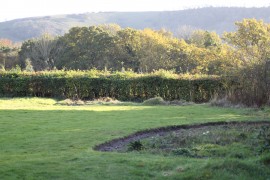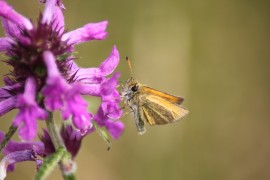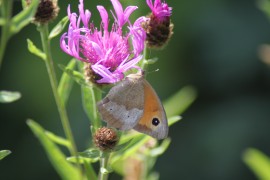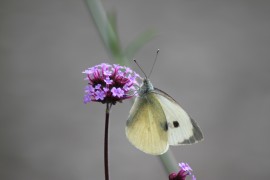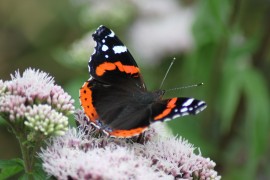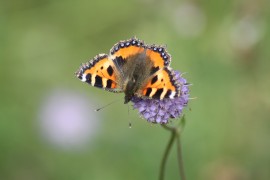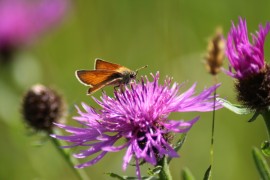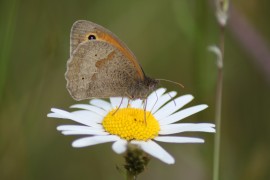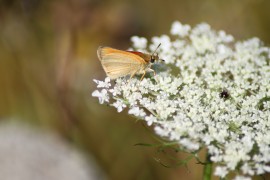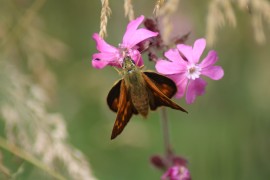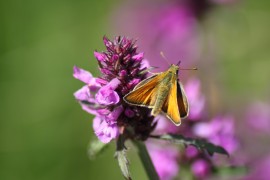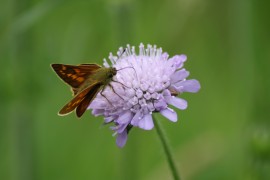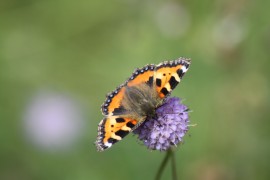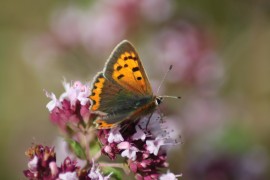Wildlife Gardening - the Herbaceous border
By Martin Kalaher
This is the first of a series of short articles on wildlife gardening, based on the 'ups and downs' of my gardening experience over the past 10-11 years. As the wildflower meadow is 'my pride and joy' I was very tempted to write about this first. However, the problem with wildflower meadows is that they need a lot of open space and realistically many gardens probably aren't quite big enough. So, I thought, why not start with the Herbaceous border as any garden-size whether it be large, medium or small can fit in a border. Now here's the challenge, what I am going to invite you gardeners to do is to stock one of your borders with British native plants only and just see what happens. I think you will be very happy with the results. I know I am.
Ideally it is best to start from scratch using clean unadulterated soil. For most gardens this will mean converting an area of lawn, in which case it is simply a matter of digging deep enough to remove the turf to include all the roots and then knock the soil back into the bed. This is easy enough with the sandy soil found in my garden but might prove a lot more difficult with clay soil (of which I have little experience). When establishing a wildflower meadow there is a lot of merit in removing all the top soil but for the Herbaceous border this isn't necessary. After all, we do want the plants to grow well and so a reasonable amount of nutrient is required.
As it happens I did things the hard way for I already had an Herbaceous border (of a sorts) but it was gradually being overwhelmed by some dominant grass species. It was time for a make-over. In September, 2014, I removed as much grass as possible from this border, leaving the perennials as islands scattered in a sea of sandy soil. As Verbena Bonariensis was already established in the front margin of the border and it is generally acknowledged as a good butterfly plant, I decided to leave it where it was. I added some White Honesty and some Devilsbit Scabious but otherwise left the bare soil alone.
In just two growing seasons I have a very reasonable balance between perennials and biennials, with a few annuals thrown in and some grass species (which will always require some attention). This mixture can only be achieved by continual soil disturbance, in effect weeding the bed in the autumn and if the winter is mild (which it usually is in West Sussex) a final weed in March. After that I leave the border alone, avoiding any further trampling during the growing season. I weed out 90% of any grass that appears, together with some species of British natives that grow rather too well in my sandy soil. Most seedlings for Ribwort Plantain, Common Sorrel, Creeping Buttercup, Red Campion and Ox-eye Daisies are removed. The experiment has proved to be very successful, with the border both pleasing to the eye and teeming with insect life. Of the 28 species of butterfly recorded in the garden in 2016 a minimum of 20 species visited and nectared in this herbaceous border. I also recorded 6 species of bumble bees together with numerous hoverflies, beetles and assorted insects that I have yet to name.
Before listing the plants that I strongly recommend I will dwell for a while on the 'blessing and curse' of sandy soil. When moist, sandy soil is easy 'to work' and the lack of nutrient is generally a blessing for the wildlife gardener. The main problem is that it drains so well and for the dry summer months there is very little moisture to sustain thirsty roots. Some plants seem to have no difficulty coping with these difficult conditions. As an example, if a Musk Mallow seedling appears on a patch of bare soil I know that I don't have to pay it any attention and it will grow very well. However, a newly-prepared border is entirely artificial and needs to be stocked either with seeds, plugs or potted plants and so lack of water could be an issue. To make matters worse I have a 'no watering' policy! OK, not with initial planting when I soak the soil (using rainwater from the water butts) but after a couple of weeks they are on their own!
So how do my plants survive both hostile soil conditions and a pedantic gardener. The key is in the preparation. With a bit of forethought and a cold frame most British native plants can be grown cheaply from seed. Annuals can be scattered on bare soil but for both biennials and perennials I would suggest using a seed tray. For the impatient gardener (and that's most of us!) consider buying plugs or small pots (if the budget will allow) but only from one of the commercial companies specialising in British plants. When I buy plugs I always 'pot them on', into small pots initially and then once I can see the roots poking through the bottom I 'pot them on' again into a bigger pot. What I am looking to achieve is a thick, deep root ball which has a much better chance of survival when planted out.
Another way of promoting good root growth is to place the potted plants in an area of virgin soil. As I am gradually extending my herbaceous border year-on-year I simply dig up another couple of feet of turf and remove all the grass and topsoil (I appreciate that this contradicts the advice already given but it does produce a bed of subsoil in the front of the border which is easy to manage). I then put in a row of potted plants, which are very accessible for watering and weeding. For each potted plant a hole is dug about three times the diameter of the pot, then partially filled with well-rotted garden compost. The plant is placed in the middle and the sides filled in with more compost. After firming it all down the plant and surrounding area is watered very thoroughly, so that the soil is completely saturated. This artificial nursery area provides me with very healthy plants with enormous root balls. A few weeks ago, I transferred a dozen Betony from this nursery area to the meadow and typically they had root balls 9-10 inches across and 7-8 inches deep. They will survive! I generally make these transfers in September or October as the plants then bed in very nicely with the heavy late autumn/winter rains that are usual for this part of West Sussex. I am not averse to spring planting but one must be prepared to do a lot more watering.
I am now going to list the plants that do well in my herbaceous border, choosing those that provide a lot of nectar, look good, and most importantly are guaranteed to attract butterflies into the garden. Where available there are photographs that show butterflies nectaring on the flower heads. When I took the photos, I was focussing on the butterflies and therefore some of the flower heads are slightly blurred.
Hemp Agrimony
In my experience, there is no other plant species in the UK that can quite compare to Hemp Agrimony in its ability to attract a whole variety of butterflies and a medley of other insects. Even Buddleia in its full glory is easily outshone by this hardy perennial. I accept that the foliage is not the most attractive and as it grows 4-6 feet high it does need to be planted at the back of the border, but every wildlife garden should have a clump or two, or maybe more! It can be locally invasive and does readily self-seed, so it needs to be kept in check.
Field Scabious
This has a very pretty flower head and proves irresistible to most butterflies and bees. It self-seeds very readily provided there is bare soil nearby but it can also be grown in a seed tray and then potted up, all at very little cost. Please do not be tempted to buy hybrids from your local garden centre as they are unlikely to survive more than a year or so.
Devilsbit Scabious
This perennial has a beautiful flower head and as it flowers in late July/through August it provides much needed nectar when many other British natives have long gone to seed. A well-known member of Butterfly Conservation (he lives in Herstmonceux) told me many years ago that some commercial companies sell the Continental variety of Devilsbit Scabious and indeed, this is what I was sold all those years ago. The 'Continental' or 'Early' variety flowers in May/early June and so having both in the garden is not necessarily a bad thing. I now have both and since there is no cross-over of the flowering season I assume there is no possibility of encouraging genetic impurities. Although Devilsbit Scabious does self-seed in my garden it doesn't do so very readily and so I have found that the better option is to collect the seeds and use a seed tray. Once established the larger clumps can be split in September or October.
Greater Knapweed
More usually associated with the wildflower meadow this also looks good in the herbaceous border. It grows very well, with the clumps enlarging year on year. It has an interesting, intricate, stunning flower head. It self-seeds readily and as with many perennials the larger clumps can be divided in the autumn.
Stocks
There are four types of Stocks that I would strongly recommend in the herbaceous border. I'll mention Cuckooflower or Lady's Smock as it is a lovely early spring perennial, which 'draws in' Orange-tips. It thrives in damp, grassy locations but unfortunately doesn't do well in my well-drained, sandy soil! However, both Pink and White Honesty do grow very well in my garden and they also attract Orange-tips. These very pretty biennials appear in late spring, when not many other British-natives are in flower. Finally, there is Dame's Violet a very attractive perennial on which I have seen both Large White and Orange-tip caterpillars. They all self-seed readily but collecting the seed and using a seed tray will guarantee a succession of plants.
Musk Mallow
Lovely pink flower heads, a must for any herbaceous border. Self-seeds and grows very well in sandy soil. Interestingly, I haven't a single photo of a butterfly on this plant species. In 2017 I must make try to rectify this.
Ox-eye Daisy
Another plant better associated with the wildflower meadow but it is a nice addition to the herbaceous border. I rather like the big, bold flower heads. I was first introduced to this native perennial as a six-year-old whilst on a family holiday. At the time, I told myself I would have them in my own garden someday. It took 47 years but I got there in the end! However, beware, for it does self-seed prolifically, so be prepared to remove surplus seedlings once or twice a year.
Wild Carrot
Arguably the loveliest of the Umbellifers I like a few Wild Carrot in the garden. It attracts a large range of hoverflies and beetles. As it can easily dominate a border, surplus plants need to be pulled out regularly.
Red Campion
A lovely perennial for spring/early summer this plant species also needs regular weeding, otherwise it can easily take over the whole bed.
Viper's Bugloss
The basal leaves are not the prettiest but the multi-flowered stem is very impressive and bumble bees find it quite irresistible. In 2016 I recorded 70-100 bumble bees in the garden some days, most of which were centred on this native biennial. There were often six species of bumble bee within two-three square metres. Awesome! It is easy enough to lose this plant from the border for although it self-seeds readily enough, it does require lots of bare soil if it is to germinate every year. As with all our native plants one can collect the seed (suitably protected with thick garden gloves!) and use a seed tray.
Marjoram and Betony
The introduction of Marjoram and Betony to the wildflower meadow in 2015 dramatically increased the numbers of butterflies in high summer. There is no reason why they shouldn't also have a place in the Herbaceous border but as they both have relatively short stems they are best planted in the front of the border. As with conventional gardening, patches or clumps of plants not only look good but also seem to encourage nectaring insects.
Verbena Bonariensis
Although not a British native, it is highly rated by Butterfly Conservation and since it grows so readily in sandy soil I have added it to the list. My personal experience is not quite so favourable as BC for although both Large and Small Whites readily visit the flower heads (as does the occasional Small Tortoiseshell), most other butterflies seem to ignore it, preferring alternative sources of nectar in the garden. It does flower late in the season when many other plants have gone to seed, so that is a definite bonus.
In my herbaceous border, I have all the above and others including, Hedge and Marsh Woundwort, Common Figwort, Cow's Parsley, Purple and Yellow Loosestrife, Common Fleabane, Greater Celandine, Red and White Deadnettle, Aquilegia Vulgaris, Common Sorrel, Ribwort Plantain, Hawkweeds, various wild Geraniums, Corn Cockle and many, many more. Some I have planted over the past 10-11 years and some have just appeared, simply by disturbing the soil. The net result is that there is a very large seed bank in the garden soil.
I have no doubt that the key to attracting many different species of insects to the garden is a large variety of plants. We do have garden hybrids in the beds adjacent to the patio but otherwise (and except for Verbena Bonariensis) the back garden only contains British natives. This article is all about creating a different type of herbaceous border, full of pretty flowers but also highly attractive to our native insects. Of course, it is not enough to attract to attract them in, we also need to provide larval food plants. This will be covered in another article.
All the British natives listed above (in bold print) grow very well in sandy soil (except Cuckooflower) and if there is room I would include them all. As to which species attract the most butterflies I will list them as follows, with some notes attached: Hemp Agrimony leads the pack by a country-mile, followed by other contenders such as Field Scabious, Marjoram, Betony, Greater Knapweed and Devilsbit Scabious. These plants produce a lot of nectar and are visited frequently by most of my garden butterflies. Honesty and Dame's Violet have very pretty flower heads and would not look out of place in the most conventional of gardens as they brighten up our spring/early summer, and encourage Orange-tips into the garden. Otherwise Ox-eye Daisy, Wild Carrot, Red Campion and Musk Mallow all brighten up the border but are not quite in the same league as those previously mentioned. Whilst not too many butterflies visit Viper's Bugloss it is the best bumble bee plant species I know, so 'a must' for all wildlife enthusiasts.
Martin Kalaher
November 2016
Read part two: Wildlife Gardening - the Wildflower meadow.
Read part three: Wildlife Gardening - the Background foliag.
Read part four: Wildlife gardening - Breeding butterflies and other wildlife
If you have any questions you would like to ask Martin please email web@sussex-butterflies.org.uk.



